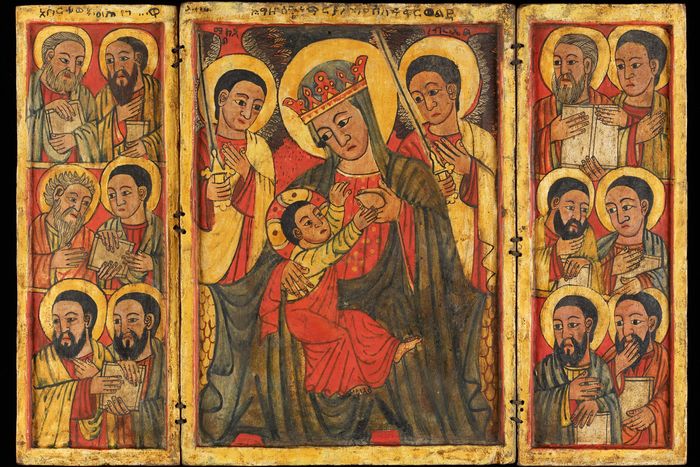
In the year 286, Emperor Diocletian began to formalize a division of the Roman Empire into two parts. The Western Roman Empire would go on to become something of a decaying backwater, while the eastern half of the empire — known by historians as the Byzantine Empire — flourished for another thousand years and more. It was never utopia. It was centered on an estuary, where commerce, philosophy, and art flowed into the capital, Constantinople. At times, the Byzantine Empire grew to include areas of present-day Italy, Syria, Tunisia, Spain, and beyond. It died in 1453, when Constantinople’s gigantic guarding walls were breached by the Ottomans.
To walk the remains of these walls today is a humbling reminder of how powerful this empire was. Since then, Byzantium has become a repository of romantic dreams, particularly for those who look at history and its cultural riches through a Western-centric lens. For many in the art world, Byzantium remains what Yeats called an “artifice of eternity” — a dream of civilization that was lost.
The Met’s recent show “Africa & Byzantium” situated itself differently: not in Constantinople and Europe, but in the African regions of the empire, which in turn cast the whole of Byzantium in a new light.
The show included a staggering 180 objects, among them beautiful Christian ivory reliefs, bronzes of Black figures, crystal animal sculptures, frescos from a Sudanese church, mosaics that left us randy, and some of the most ravishing illuminated manuscripts ever made. Here was one of my favorite objects: a complete 15th-century Ethiopian Illuminated Gospel, opened to a figurative image of Saint John. He is enshrined within a yellow-red grid, exhibiting a frontality that is both post-Egyptian and premodern. It is almost its own art form.
The modern concept of race is turned on its head. A showstopper at the entrance to the show told us that, as curator Andrea Achi noted of the period, different people came into contact, but their skin color was not viewed as a marker of class or rank. A large mosaic depicts the preparation for a feast, and features an apparent range of skin colors and ethnicities. Each figure is hunky and dressed in a different style of clothing: a toga, a one-shouldered frock, and a kind of cape whose fabric is tossed over the arm.
Lady of Carthage is a mosaic that defies Cato the Elder’s supposed demand that “Carthage must be destroyed.” The powerful female figure stands as a symbol of the longevity of the Eastern empire, which would go on to outlive its Western counterpart by a millennium. She is a North African woman in robes who holds a scepter and has her hair piled high. She is a deity, a ruler, and a warrior all in one.
Also noteworthy was a sixth-century painting of the Virgin with child. It astonishes because of two turned angels in the background, each depicted in a three-quarters view with gradated perspective. This was made almost a thousand years before perspective was supposedly invented in 15th-century Florence. The Virgin looks warily to her right, as if to protect the child seated on her lap, who is turned to the left and raises one hand in beneficent blessing. This miracle of art tells us that many cultures “discovered” perspective, not only the West.
A wooden bridal chest is inlaid with 21 ivory panels of fine calligraphic curves. Goddesses take pleasure in themselves, and a wonderful polymorphous sexuality underlies it all. The labels let you track materials from all over the world. This is because getting around was easy. Egypt to Constantinople might take 16 days by ship; Carthage to Rome was a five-day trip. Business, pleasure, and trade brought materials from everywhere, and helped create the art and culture of this epic empire.
Finally, there were the great illuminated manuscripts, icons, and bibles. The sun shined brighter in these galleries. We saw a style of figuration rise to eternal heights and graphic resoluteness and intensity. We saw Byzantium rise again and anew.

